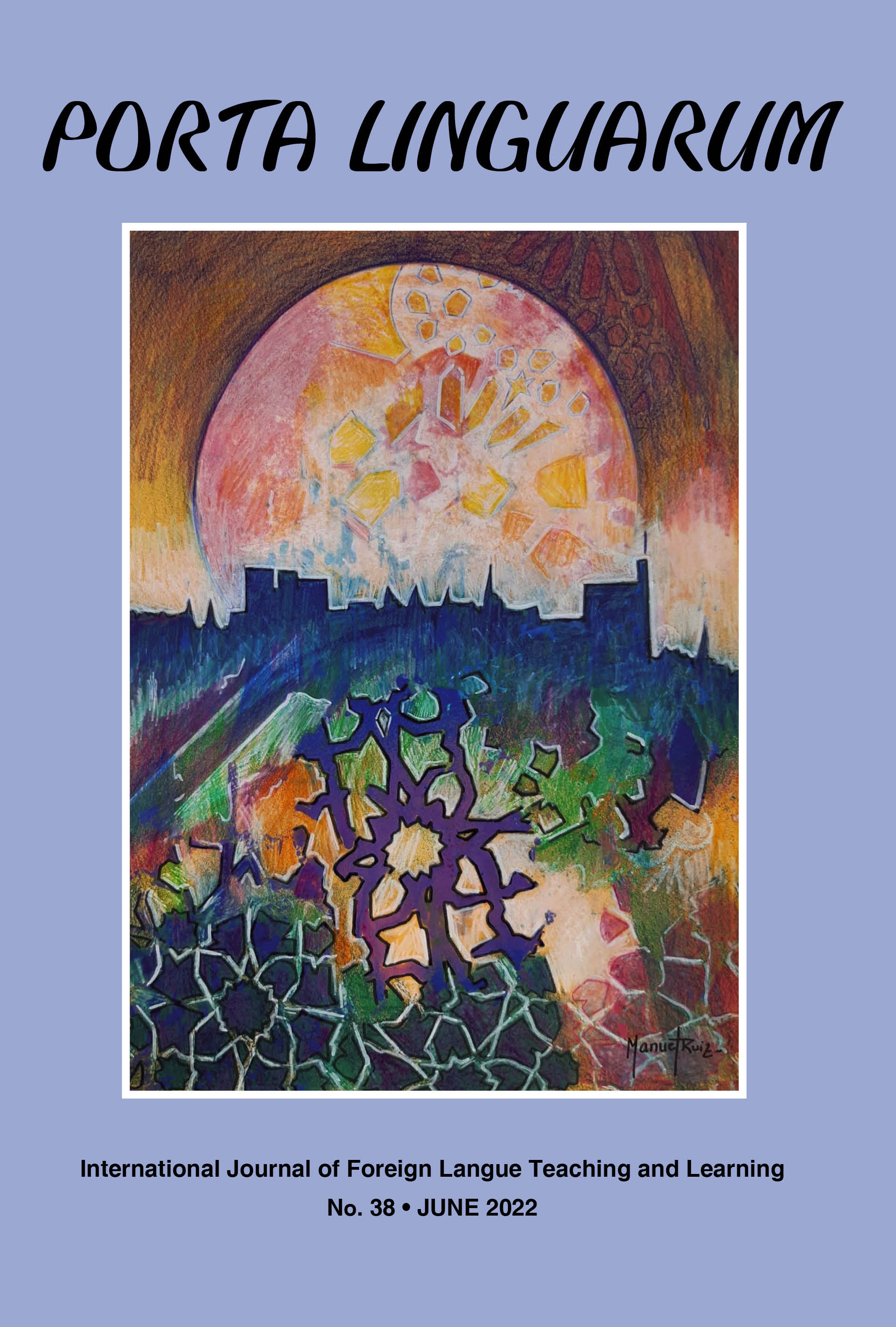Effectiveness of textually-enhanced captions on Chinese high-school EFL learners’ incidental vocabulary learning
DOI:
https://doi.org/10.30827/portalin.vi38.23511Palabras clave:
Tipos de subtítulos, visualización de videos, aprendizaje de idiomas extranjeros, aprendizaje de vocabulario, brillo L1Resumen
- Este estudio investigó el impacto y las percepciones de los estudiantes de los subtítulos mejorados textualmente en las ganancias incidentales de vocabulario de los estudiantes de inglés como lengua extranjera en un entorno de aprendizaje multimodal. 133 estudiantes chinos de inglés como lengua extranjera de nivel intermedio bajo fueron asignados aleatoriamente a subtítulos en inglés con palabras objetivo resaltadas y brillo L1 (ECL1), subtítulos en chino e inglés (CEC), subtítulos en chino e inglés con palabras objetivo resaltadas (CECGW), y sin subtítulos (NC). Nuestros hallazgos cuasi-experimentales no detectaron diferencias significativas entre los tipos de subtítulos en el reconocimiento de formas de vocabulario, mientras que ECL1 resultó ser el más efectivo para recordar y reconocer significados. Nuestros datos cualitativos sugirieron que los participantes generalmente veían los videos subtitulados de manera positiva, con variabilidad en las percepciones de la presentación simultánea de información. La prominencia del brillo L1 podría dirigir la atención de los espectadores a las palabras objetivo y reforzar las conexiones de la forma del sonido y el significado.
Descargas
Citas
Cohen, J. (1988). Statistical power analysis for the behavioral sciences (2nd ed.). Academic Press.
Dai, J. (2005). Captioned video and foreign language learning. Technology Enhanced Foreign Language Education, 103, 18-22.
Danan, M. (1992). Reversed subtitling and dual coding theory: New directions for foreign language instruction. Language Learning, 42(4), 497–527.https://doi.org/10.1111/j.1467-1770.1992.tb01042.x
De Guerrero, M., & Commander, M. (2013). Shadow-reading: Affordances for imitation in the language classroom, Language Teaching Research, 2013, 17(4), 433-453.https://doi.org/10.1177/1362168813494125
Fernández-Costale, A. (2021). Subtitling and Dubbing as Teaching Resources in CLIL in Primary Education: The Teachers’ Perspective, Porta Linguarum, 36, 175-192. https://doi.org/10.30827/portalin.v0i36.16228
Frick, T.W., Chadha, R., Watson, C., Wang, Y., & Green, P. (2009). College student perceptions of teaching and learning quality. Educational Technology Research and Development, 57(5), 705–720. https://doi.org/10.1007/s11423-007-9079-9
Gass, S. M. (1999). Discussion: Incidental vocabulary learning. Studies in Second Language Acquisition, 21(2), 319–333.
Gerbier, E., Bailly, G., & Bosse, M. (2018). Audio-visual synchronization in reading while listening to texts: Effects on visual behavior and verbal learning. Computer Speech and Language, 47 (1):79-92. https://doi.org/ff10.1016/j.csl.2017.07.003f
Hsieh, H.F., & Shannon, S. E. (2005) Three approaches to qualitative content analysis. Qualitative Health Research, 15(9): 1277–1288. https://doi.org/10.1177/1049732305276687
Hsieh, Y. (2020). Effects of video captioning on EFL vocabulary learning and listening comprehension. Computer Assisted Language Learning, 33(5-6), 567-589. https://doi.org/10.1080/09588221.2019.1577898
Hsu, C.K., Hwang, G.J., Chang, Y.T., & Chang, C.K. (2013). Effects of video caption modes on English listening comprehension and vocabulary acquisition using handheld devices. Educational Technology & Society, 16(1), 403-414.
Kam, E.F., Liu, Y.T., & Tseng, W.T. (2020). Effects of modality preference and working memory capacity on captioned videos in enhancing L2 listening outcomes. ReCALL, 32(2), 213–230. https://doi.org/10.1017/S0958344020000014
Kang, H., Kweon, S. & Choi, S. (2020). Using eye-tracking to examine the role of first and second language glosses. Language Teaching Research, 6, 1-22. https://doi.org/10.1177/1362168820928567
Leonhardt, J. (2020). Using film and media in the language classroom: reflections on research-led teaching. ELT Journal, 74(2), 229–231. https://doi.org/10.1093/elt/ccaa007
Leveridge, A.N., & Yang, J.C. (2014). Learner perceptions of reliance on captions in EFL multimedia listening comprehension, Computer Assisted Language Learning, 27(6), 545-559. https://doi.org/10.1080/09588221.2013.776968
Li, M. (2016). An Investigation into the Differential Effects of Subtitles (First Language, Second Language, and Bilingual) on Second Language Vocabulary Acquisition. PhD thesis. Edinburgh: University of Edinburgh.
Liao, S., Kruger, J., & Doherty, S. (2020). The impact of monolingual and bilingual subtitles on visual attention, cognitive load, and comprehension. The Journal of Specialised Translation, 33, 70-98. https://www.jostrans.org/issue33/art_liao.pdf
Mayer, R.E., & Pilegard, C. (2014). Principles for managing essential processing in multimedia learning: segmenting, pre-training, and modality principles. In R. E. Mayer (Ed.), Cambridge handbook of multimedia learning (pp.307-337). New York: Cambridge.
Mayer, R.E. (2014). Cognitive theory of multimedia learning. In R. E. Mayer (Ed.), Cambridge handbook of multimedia learning (pp.55-81). New York: Cambridge.
Montero Perez, M., Peters, E., Clarebout, G., & Desmet, P. (2014). Effects of captioning on video comprehension and incidental vocabulary learning. Language Learning and Technology, 18(1), 118-141. http://llt.msu.edu/issues/february2014/monteroperezetal.pdf
Montero Perez, M., Peters, E., & Desmet, P. (2018). Vocabulary learning through viewing video: The effect of two enhancement techniques. Computer Assisted Language Learning, 31(1), 1-26. https://doi.org/10.1080/09588221.2017.1375960
Montero Perez, M. (2020). Incidental vocabulary learning through viewing video: the role of vocabulary knowledge and working memory. Studies in Second Language Acquisition, 42(4), 1-25. https://doi.org/10.1017/S0272263120000145
Moreno, R., & Abercrombie, S. (2010). Promoting awareness of learner diversity in prospective teachers: Signaling individual and group differences within classroom cases. Journal of Technology and Teacher Education, 18(1), 111–130. https://www.learntechlib.org/primary/p/29271/.
Neuman, S.B., & Koskinen, P. (1992). Captioned television as comprehensible input: Effects of incidental word learning from context for language minority students. Reading Research Quarterly, 27(1), 95–106.
Schmidt, R.W. (1990). The role of consciousness in second language learning. Applied Linguistics, 11(2), 129-158. https://doi.org/10.1093/applin/11.2.129
Sweller, J., Ayres, P., & Kalyuga, S. (2011). Cognitive load theory. New York: Springer.
Sydorenko, T. (2010). Modality of input and vocabulary acquisition. Language Learning & Technology, 14(2), 50–73. http://llt.msu.edu/vol14num2/sydorenko.pdf
Teng, F. (2019). Maximizing the potential of captions for primary school ESL students’ comprehension of English-language videos. Computer Assisted Language Learning, 32(7), 665-691. https://doi.org/10.1080/09588221.2018.1532912
van Gog, T. (2014). The signaling (or cueing) principle in multimedia learning. In R. E. Mayer (Ed.), Cambridge handbook of multimedia learning (pp. 255-269). New York: Cambridge.
Webb, S., & Chang, A. (2012). Vocabulary learning through assisted and unassisted repeated reading. The Canadian Modern Language Review, 68(3), 267-290.
Webb, S., & Nation, P. (2017). How vocabulary is learned. Oxford: Oxford University Press.
Yeldham, M. (2018). Viewing L2 captioned videos: What’s in it for the listener? Computer Assisted Language Learning, 31(4), 367-389. https://doi.org/10.1080/09588221.2017.1406956
Yun, J. (2011). The effects of hypertext glosses on L2 vocabulary acquisition: A meta-analysis. Computer Assisted Language Learning, 24(1), 39–58. https://doi.org/10.1080/09588221.2010.523285



















